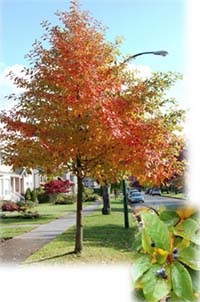Street trees in Parkhill Drive, Ashwood
Our focus is on preserving trees that are healthy and creating additional planting in local parks and reserves to boost greenery.
We will only be removing and replacing those trees that are dead, dying (with a useful life expectancy of less than two years) or dangerous (they pose a risk to the community in the short term).
Street Tree Assessments
Our arborists have completed individual tree assessments based on the above criteria. In Parkhill Drive, we are proposing to remove 8 trees and will be planting a total of 25 trees, which includes an additional 17 trees in vacant location.
Replacement Tree Species
Council's arborist has proposed four appropriate tree species to be considered for planting. In some cases, we will need to select two complementary species to be planted on either side of the road to accommodate constraints such as power lines, service pits and other infrastructure that exists within the street.
A proposed street tree renewal plan including all proposed tree removals, replacements and species choices has been drafted for Parkhill Drive, Ashwood:
Parkhill Drive - Proposed Tree Renewal Plan(PDF, 2MB)
We will be seeking feedback on the preferred species from all directly affected residents via an online survey or postal vote. The species of tree that receives the majority of preferences will be planted in 2020, after the removal of trees identified in the plan.
Survey Results
Council sought community feedback (reply paid mail survey and online) on the preferred option of tree species directly affected residents would like to see planted in their street (until Friday 23 August 2019).
As a result of the recent survey on the preferred tree species for Parkhill Drive, your street has selected Option 1 – “Callistemon viminalis, Weeping Bottlebrush”.
This tree will be planted between July and September 2020.
Council will be responsible for the care of the new street trees for the first two years as they become established. However our residents can play a vital role in their successful establishment by keeping an eye on them and reporting to Council if they see the tree is not looking well or has been damaged.
The trees will then become part of Council’s annual tree maintenance program, where they will be checked and pruned, if necessary.
Thank you for providing your feedback to renew your streetscape and Monash’s highly valued tree canopy.
Please see voting results:
- Option 1: 4 votes
- Option 2: 2 votes
- Option 3: 3 votes
For more information, please contact Lucas Skelton, Manager Horticulture, on 9518 3555.
Option 1 - Single species (both sides of the road)
Power line side / Non-power line side

Callistemon viminalis - Weeping Bottle Brush
This is a pretty bird-attracting tree with a heavy crown due to the profusion of brilliant red flowers in spring and summer. It is the weight of these flowers that gives it a pendulous habit.
Mature Size (h x w): 6-8m x 6-8m
Form: Round
Option 2 - Single species (both sides of the road)
Power line side / Non-power line side

Cercis canadensis 'Forest Pansy' - Forest Pansy Redbud
This small, attractive tree has spectacular heart-shaped, burgundy-coloured leaves that continually change colour throughout the year. A rich purple in spring, the foliage transforms to green over summer, followed by a multi-coloured autumn display in tones of red, apricot and gold. The branches have a distinctive, smooth, dark brown wood which contrasts well with the blossom like pink flowers that are born before the re-emergence of leaves in spring.
Mature Size (h x w): 5-7m x 5-7m
Form: V-Shaped
Option 3 - Combination of species
Non-power line side

Nyssa sylvatica - Black Tupelo
A medium-sized tree, the Black Tupelo has dark green leaves in summer becoming an amazing glowing orange red and yellow colour in autumn. A slow growing variety with highly ornamental bark and great autumn foliage.
Mature Size (h x w): 8-12m x 6-10m
Form: Pyramid
Power line side

Acer campestre 'Elsrijk' - Elsrijk Maple
A small tree with a dense round canopy, and a somewhat corky bark. Small leaves with rounded lobes, dark green in summer, which turn a beautiful clear yellow in the autumn. Green inconspicuous flowers from September to October. Paired samaras spread throughout the tree and hang in clusters well into winter.
Mature Size (h x w): 8-10m x 7m
Form: Round